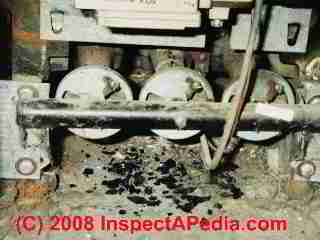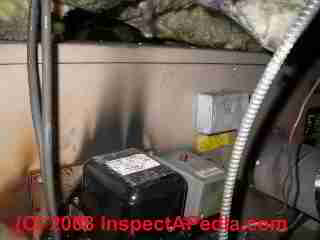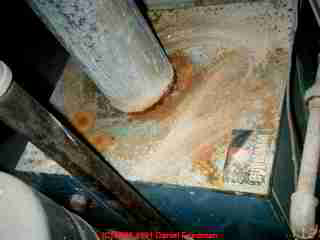 Visual Evidence of Combustion Air Defects
Visual Evidence of Combustion Air Defects
How to Recognize Combustion Air Problems
- POST a QUESTION or COMMENT about combustion air requirements and safety hazards for oil and gas fired heating appliances
Effects in buildings of inadequate combustion air:
This article describes the effects of inadequate combustion air in buildings and on building heating equipment. Simply visual clues such as soot deposits can give advance warning of potentially fatal carbon monoxide hazards, fire hazards, or equipment malfunction that means loss of heat or hot water.
Watch out: if you see chunks of soot at a gas burner such as shown in our page top photo the situation is very dangerous as there is a good chance of fatal carbon monoxide gas release in the building. Turn off the equipment and call for professional help.
This article series explains how to recognize and fix combustion air defects on heating appliances such as boilers, furnaces, and water heaters. These articles answer most questions about central hot water heating system troubleshooting, inspection, diagnosis, and repairs.
InspectAPedia tolerates no conflicts of interest. We have no relationship with advertisers, products, or services discussed at this website.
- Daniel Friedman, Publisher/Editor/Author - See WHO ARE WE?
A Guide to Combustion-Air-Related Heating Equipment Malfunctions & Their Implications
 Here we list common ways that inadequate combustion air shows up in a building as malfunctioning heating equipment, noises, soot, odors. Some of these conditions are dangerous.
Here we list common ways that inadequate combustion air shows up in a building as malfunctioning heating equipment, noises, soot, odors. Some of these conditions are dangerous.
- Noises & soot buildup can lead to a potentially dangerous puffback which can damage the heating equipment and blow soot and smoke throughout the building.
See SOOT on OIL FIRED HEATING EQUIPMENT
and
see GAS BURNER FLAME & NOISE DEFECTS - Lack of adequate combustion air can result in improper system operation, sooting, loss of heat, noises, smoke, and potentially, the production of carbon monoxide or other flue or combustion gases which escape into the building - potentially dangerous
Watch out: if adequate combustion air is not provided to an oil or gas burner, woodstove, fireplace or other fuel burning appliances, simply closing a door, opening an upper floor window, or turning on exhaust fans or a whole house fan can convert from a condition in which everything seemed OK to a dangerous situation with dangerous carbon monoxide production.
See BACKDRAFTING HEATING EQUIPMENT
- Ignition transformer failure, Leaky oil at an oil burner ignition transformer an indicate a combustion air problem: watch for back pressure in combustion chamber -- watch out for blocked heating flue or blocked chimney - these would be unsafe, or the heater may be unreliable.
An unreliable heater can lead to frozen burst pipes and costly building damage. A blocked chimney could lead to a potentially fatal carbon monoxide hazard. - Heating System Odors: while carbon monoxide is odorless and colorless, when it is being produced by heating equipment it may be mixed with flue gases that indeed have a distinctive odor. If you smell oil, gas, or other unidentified odors in a building, be sure that the safety of all heating equipment and chimneys is included in your investigation.
See HEATING SYSTEM ODORS
- Unusual interior moisture conditions, noises, smoke, or odors during heating season--watch for blocked chimney or poor flue vent connections. For example, a blocked chimney at a gas fired appliance or inadequate combustion air can result in excessive moisture discharge (along with dangerous flue gas) into the building interior.
Watch out: At UNLINED FLUE INSPECTIONS the rusty gas boiler top shown above is the heater discussed when we describe a near-fatality in Port Jervis New York. The chimney for a gas fired boiler became blocked. Once a gas boiler or furnace or water heater / calorifier has gotten up to normal operating temperature you should not feel flue gas spillage at the heater's draft hood. Be sure that chimney and heater repairs are performed by a qualified, certified expert.
A blocked chimney flue can give similar symptoms to blocked combustion air inlet: that is, most of the problems presented in this list. - Equipment recalls: Specific heating system problem brands Repco, Blueray etc.
[Do not confuse Repco™ heating boilers, which had fire chamber and other failures, with other products (REPCO pumps, REPCO controls, REPCO water conditioners, or water treatment that carry the Repco name. Those products are distinct from REPCO heating boilers and are produced/distributed by the R.E. Prescott Company. Further, we are unaware of any remaining warranty or replacement support for failed or antiquated Repco heating boilers.] - BACKDRAFTING HEATING EQUIPMENT - causes of flue gas spillage and explanation of the hazards
- BLUE vs YELLOW COMBUSTION FLAMES - the Blueray history and blue flame vs. yellow flame combustion, flame color & combustion efficiency, & how oil competes with gas as a heating fuel.
...
Continue reading at COMBUSTION AIR DEFECTS or select a topic from the closely-related articles below, or see the complete ARTICLE INDEX.
Or see this
Article BACKDRAFTING HEATING EQUIPMENTSeries Contents
- CARBON MONOXIDE WARNINGS: HOME HEATERS
- COMBUSTION AIR REQUIREMENTS
- CLUES INDICATING INADEQUATE COMBUSTION AIR
- COMBUSTION AIR DEFECTS
- COMBUSTION AIR DEFECT EFFECTS
- COMBUSTION AIR RULES of THUMB
- COMBUSTION AIR vs ROOM SIZE
- COMBUSTION AIR DUCT SIZE vs BTUh
- COMBUSTION AIR for POWER BURNERS
- COMBUSTION AIR INLET AUTOMATIC LOUVERS
- COMBUSTION AIR INLETS vs COLD DRAFTS
- COMBUSTION AIR SAFETY CHECK
- COMBUSTION AIR SAFETY in MOBILE HOMES
- COMBUSTION AIR for TIGHT BUILDINGS
- COMBUSTION AIR for WOODSTOVES
- UN-VENTED GAS HEATER SAFETY
- GAS BURNER SOOT CAUSE & CURE
Suggested citation for this web page
COMBUSTION AIR DEFECT EFFECTS at InspectApedia.com - online encyclopedia of building & environmental inspection, testing, diagnosis, repair, & problem prevention advice.
Or see this
INDEX to RELATED ARTICLES: ARTICLE INDEX to HEATING SYSTEMS
Or use the SEARCH BOX found below to Ask a Question or Search InspectApedia
Ask a Question or Search InspectApedia
Questions & answers or comments about combustion air requirements and safety hazards for oil and gas fired heating appliances
Try the search box just below, or if you prefer, post a question or comment in the Comments box below and we will respond promptly.
Search the InspectApedia website
Note: appearance of your Comment below may be delayed: if your comment contains an image, photograph, web link, or text that looks to the software as if it might be a web link, your posting will appear after it has been approved by a moderator. Apologies for the delay.
Only one image can be added per comment but you can post as many comments, and therefore images, as you like.
You will not receive a notification when a response to your question has been posted.
Please bookmark this page to make it easy for you to check back for our response.
IF above you see "Comment Form is loading comments..." then COMMENT BOX - countable.ca / bawkbox.com IS NOT WORKING.
In any case you are welcome to send an email directly to us at InspectApedia.com at editor@inspectApedia.com
We'll reply to you directly. Please help us help you by noting, in your email, the URL of the InspectApedia page where you wanted to comment.
Citations & References
In addition to any citations in the article above, a full list is available on request.
- American Society of Heating, Refrigerating and Air-Conditioning Engineers (ASHRAE) Handbook - Fundamentals, 1993, Chapter 15, page 15.9 Air For Combustion.
- ASME CSD-1- Controls and Safety Devices for Automatically Fired Boilers, 1992 with addendum 1a 1993. section CG-260 Combustion Air.
- BOCA - National Mechanical Code, 1990, article 10, Combustion Air.
- NFPA 31 - Installation of Oil Burning Equipment, 1992, section 1-5 Air for Combustion and Ventilation.
- NFPA 54: National Fuel Gas Code (2015), addresses heating appliance combustion air ventilation specifications. NFPA 54, ANSI Z223.1 provides minimum safety requirements for the design and installation of fuel gas piping systems in homes and other buildings.
- NFPA 85: Boiler and Combustion Systems Hazards Code: NFPA 85 contributes to operating safety and prevents explosions and implosions in boilers with greater than 12.5 MMBTUH, pulverized fuel systems, and heat recovery steam generators.
- NFPA 87: Recommended Practice for Fluid Heaters, This recommended practice provides safety guidance for fluid heaters and related equipment to minimize fire and explosion hazards that can endanger the fluid heater, the building, or personnel
- SBCCI- Standard Mechanical Code, 1991, section 305 Combustion and Ventilation Air.
- Axtman, William H., "Combustion Air Requirements: The Forgotten Element in Boiler Rooms", Grayh Gull Associates, retired executive director of the American Boiler Manufacturers Association, National Board Technical Series, Winter 1995 National Board Bulletin. Retrieved 26 January 2015, original source: http://www.nationalboard.org/index.aspx?pageID=164&ID=191
Excerpt:
Several safety codes such as the National Fire Protection Association's standards, NFPA 54 - National Fuel Gas code, NFPA 31 - Installation of Oil Burning Equipment, and the American Society of Mechanical Engineers (ASME) CSD-l Controls and Safety Devices for Automatically Fired Boilers have sections covering the requirements for combustion air intakes. In addition, building codes such as the Building Officials and Code Administrators International (BOCA) National Mechanical Code and the Standard Mechanical Code published by the Southern Building Code Congress International (SBCCI) have air requirements for combustion.
Editor's note: Some ASME Boiler and Pressure Vessel Code requirements may have changed because of advances in material technology and/or actual experience. The reader is cautioned to refer to the latest edition and addenda of the ASME Boiler and Pressure Vessel Code for current requirements. - Nussbaumer, Thomas. "Combustion and co-combustion of biomass: fundamentals, technologies, and primary measures for emission reduction." Energy & fuels 17, no. 6 (2003): 1510-1521.
- Utiskul, Yunyong P., Wu, Neil P., Biteau, Hubert, "Combstion Air Requirements for Power Burner Appliances, Final Report", The Fire Protection Research Foundation, The Fire Protection Research Foundation
One Batterymarch Park
Quincy, MA, USA 02169-7471
Email: foundation@nfpa.org
http://www.nfpa.org/foundation, retrieved 25 Jan 2015, original source: http://www.nfpa.org/~/media/files/research/research%20foundation/rfcombustionairrequirements.ashx, Executive Summary:
Gas-fired appliances require combustion air to properly function. Adequate air is necessary for
supporting combustion of the appliance burner, dilution of flue gas, and proper ventilation of the
space where the appliance is installed. Current standards and model codes outline requirements
and methods to supply the combustion air. One method is to provide outdoor combustion air
through openings or air ducts communicating with the outdoors through natural ventilation.
Most standards require the outdoor opening(s) be prescriptively sized based on the total energy
input rating of the appliance. However, in the United States, the current standards contain no
separate provisions to address the opening size supplying the combustion air for
commercial/industrial sized appliances, which typically have a high energy input rating of
greater than 300 kBtu/hr and are equipped with a power burner unit. As a result, the opening(s)
can be excessively sized when determined based on the current standards.
This research project establishes minimum outdoor combustion air requirements specific to gasfired
appliances utilizing power burners with input ratings no greater than 12.5 MBtu/hr. A
review of the available literature, engineering guidelines, and current standards and model codes
related to combustion air requirements was performed. This report provides an understanding
of the technical basis for the existing provisions for combustion air and their applicability to
power burner appliances. This report also identifies the range of energy input ratings for gasfired
appliances equipped with power burners, and compares the combustion air requirements
specified by a range of appliance manufacturers. A theoretical model for air flow through
openings was developed and the modeling results, together with the data gathered through the
literature review, were used to provide a baseline to establish the theorized combustion air
requirements suitable for power burner appliances.
... - [1] Jeff Wilcox, "Evaluating Duct Work, How to Evaluate Furnace Duct Work & Cure Short Cycling or Inadequate Ductwork Problems" Vermont Department for Children and Families, Office of Economic Opportunity, - dcf.vermont.gov/sites/dcf/files/pdf/oeo/WAPManual/AppendixI.pdf retrieved 12/5/2013. Geoff Wilcox Vermont Office of Economic Opportunity Weatherization Assistance Program Waterbury, VT (802) 769-8376 Geoff.wilcox@state.vt.us Reference Material for the original article came from: 1. Saturn Mechanical Systems Field Guide 2. Bacharach (Rudy Leatherman)
- Field Controls provides instructions for the installation of LP and Natural Gas spill sensor switches, for example for their Gas Spillage Sensing Kit Model GSK-3, GSK-4, GSK-250M switches. Contact your heating service technician directly, or contact Field controls at fieldcontrols.com for more information. These switch models include a manual reset switch. Field Controls, Kingston NC 28504 - Tel 252-522-3031.
- Tjernlund Products provides instructions for the installation and use of their controls, including the WHKE Millivolt Interlock Kit for use with their UC1 Universal Control, MAC1E or MAC4E auxiliary controls for gas fired equipment. This document also describes Tjernlund's recommended combustion air safety check which we recommended in this article. Contact Tjernlund Products at tjernlund.com or at 800-255-4208.
- Bachrach Corporation, www.bachrach-training.com provides education for HVAC technicians. We found their web pages hanging during loading -01/2009. Readers may want to contact the company directly at: bacharach-inc.com or at 800-736-4666.
- R.E. Prescott Company, a producer of other REPCO™ residential and industrial products as well as a provider of design-build engineering services is at 10 Railroad Avenue, Exeter, NH 03833. Tel: 603-722-04321 or 888-786-7482. Trish O'Keefe from Prescott informed us (10/7/2009) that their company had nothing to do with the failed Repco heating boilers discussed at InspectAPedia.com. She wrote:
- Our company manufactures & distributes residential water treatment equipment, including our Repco line of conditioners. We have a plumbing & heating supply dept as well. We are mistaken for the Repco Boiler company on a regular basis, most frequently in Oct. and Nov.
- Any information you could give me on the other Repco company would be appreciated. We've assumed it is no longer in business, and we'd like to know that for sure. Many callers want to know where to get replacement parts and I would be glad to direct them if I knew...plus there's always a chance they might be interested in a Crown Boiler instead
- Our recommended books about building & mechanical systems design, inspection, problem diagnosis, and repair, and about indoor environment and IAQ testing, diagnosis, and cleanup are at the InspectAPedia Bookstore. Also see our Book Reviews - InspectAPedia.
- Domestic and Commercial Oil Burners, Charles H. Burkhardt, McGraw Hill Book Company, New York 3rd Ed 1969.
- National Fuel Gas Code (Z223.1) $16.00 and National Fuel Gas Code Handbook (Z223.2) $47.00 American Gas Association (A.G.A.), 1515 Wilson Boulevard, Arlington, VA 22209 also available from National Fire Protection Association, Batterymarch Park, Quincy, MA 02269. Fundamentals of Gas Appliance Venting and Ventilation, 1985, American Gas Association Laboratories, Engineering Services Department. American Gas Association, 1515 Wilson Boulevard, Arlington, VA 22209. Catalog #XHO585. Reprinted 1989.
- The Steam Book, 1984, Training and Education Department, Fluid Handling Division, ITT [probably out of print, possibly available from several home inspection supply companies] Fuel Oil and Oil Heat Magazine, October 1990, offers an update,
- Principles of Steam Heating, $13.25 includes postage. Fuel oil & Oil Heat Magazine, 389 Passaic Ave., Fairfield, NJ 07004.
- The Lost Art of Steam Heating, Dan Holohan, 516-579-3046 FAX
- Principles of Steam Heating, Dan Holohan, technical editor of Fuel Oil and Oil Heat magazine, 389 Passaic Ave., Fairfield, NJ 07004 ($12.+1.25 postage/handling).
- "Residential Steam Heating Systems", Instructional Technologies Institute, Inc., 145 "D" Grassy Plain St., Bethel, CT 06801 800/227-1663 [home inspection training material] 1987
- "Residential Hydronic (circulating hot water) Heating Systems", Instructional Technologies Institute, Inc., 145 "D" Grassy Plain St., Bethel, CT 06801 800/227-1663 [home inspection training material] 1987
- "Warm Air Heating Systems". Instructional Technologies Institute, Inc., 145 "D" Grassy Plain St., Bethel, CT 06801 800/227-1663 [home inspection training material] 1987
- Heating, Ventilating, and Air Conditioning Volume I, Heating Fundamentals,
- Boilers, Boiler Conversions, James E. Brumbaugh, ISBN 0-672-23389-4 (v. 1) Volume II, Oil, Gas, and Coal Burners, Controls, Ducts, Piping, Valves, James E. Brumbaugh, ISBN 0-672-23390-7 (v. 2) Volume III, Radiant Heating, Water Heaters, Ventilation, Air Conditioning, Heat Pumps, Air Cleaners, James E. Brumbaugh, ISBN 0-672-23383-5 (v. 3) or ISBN 0-672-23380-0 (set) Special Sales Director, Macmillan Publishing Co., 866 Third Ave., New York, NY 10022. Macmillan Publishing Co., NY
- Installation Guide for Residential Hydronic Heating Systems
- Installation Guide #200, The Hydronics Institute, 35 Russo Place, Berkeley Heights, NJ 07922
- The ABC's of Retention Head Oil Burners, National Association of Oil Heat Service Managers, TM 115, National Old Timers' Association of the Energy Industry, PO Box 168, Mineola, NY 11501. (Excellent tips on spotting problems on oil-fired heating equipment. Booklet.)
- In addition to citations & references found in this article, see the research citations given at the end of the related articles found at our suggested
CONTINUE READING or RECOMMENDED ARTICLES.
- Carson, Dunlop & Associates Ltd., 120 Carlton Street Suite 407, Toronto ON M5A 4K2. Tel: (416) 964-9415 1-800-268-7070 Email: info@carsondunlop.com. Alan Carson is a past president of ASHI, the American Society of Home Inspectors.
Thanks to Alan Carson and Bob Dunlop, for permission for InspectAPedia to use text excerpts from The HOME REFERENCE BOOK - the Encyclopedia of Homes and to use illustrations from The ILLUSTRATED HOME .
Carson Dunlop Associates provides extensive home inspection education and report writing material. In gratitude we provide links to tsome Carson Dunlop Associates products and services.


